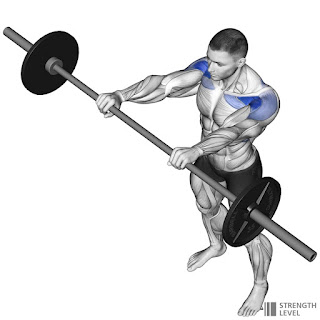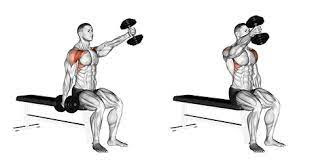Barbell Front Raises for Bigger Deltoids
Muscles Worked by Barbell Front Raises
Anatomy of the deltoids
The deltoids are a triangular muscle that covers the shoulder joint. The front delts (anterior deltoid) is the largest and most powerful of the three heads and is responsible for much of the shoulder's forward movement.
The middle deltoid (lateral head) abducts the arm away from the body, while the posterior deltoid (rear head) extends and externally rotates the arm. All three heads work together to stabilize the shoulder joint.
How to do Barbell Front Raises
Incline Barbell Front Raises
Alternatives to Barbell Front Raises
Benefits of Barbell Front Raises
There are many benefits that barbell front raises offer. In addition to building muscle mass, this exercise can also help improve your posture and increase your range of motion. Additionally, barbell front raises can help to prevent injuries by strengthening the muscles and connective tissues around the shoulder joint.
If you're looking for a great exercise to add to your shoulder workout routine, look no further than barbell front raises! Give them a try and see for yourself how effective they can be. You won't be disappointed!
Tips for Better Barbell Front Raises
Doing barbell front raises with proper form is important in order to avoid injury and get the most out of the exercise. Here are some tips to keep in mind:
-Keep your core engaged throughout the entire movement. This will help to stabilize your spine and protect your lower back from injury.
-Don't swing the weight up. The movement should be controlled and deliberate.
-Keep your shoulders down and back, and resist the temptation to shrug them up towards your ears.
-Pause for a moment at the top of the movement, then slowly lower the weight back down to the starting position.
Conclusion
Barbell front raises are a great way to build strength in the muscles around your shoulder joint. When done with proper form, they can help maximize muscle activation and minimize the risk of injury.
Follow these tips to ensure you're doing barbell front raises correctly: keep your core engaged, don't swing the weight, keep your shoulders down, pause at the top of each rep, and slowly lower back down to starting position. Give barbell front raises a try today! You won't be disappointed!
FAQs
Are barbell front raises better than dumbbell front raises?
There is no definitive answer to this question. Some people prefer barbell front raises because they can lift heavier weights and really challenge their muscles. Others find that dumbbell front raises allow for a greater range of motion and are more comfortable to perform. Ultimately, it comes down to personal preference. Try both exercises and see which one you like best.
What's the difference between a barbell front raise and a shoulder press?
A shoulder press is an overhead pressing movement in which you raise the weights above your head. A barbell front raise, on the other hand, is a horizontal pressing movement in which you raise the weights out in front of you. Both exercises work the shoulders, but they target different muscles within the shoulder girdle.
The barbell front raise primarily targets the anterior (front) deltoid, with the middle and posterior (rear) deltoids assisting. The shoulder press, on the other hand, works all three heads of the deltoid equally. So, if your goal is to build bigger shoulders, you'll want to include both exercises in your routine.
Should I use a fixed barbell for front raises?
Yes, you should use a fixed barbell for front raises. This will allow you to keep your shoulders in a stable position and better isolate the anterior deltoid.
If you don't have access to a fixed barbell, you can also use a dumbbell or kettlebell. Just be sure to keep your shoulders square and avoid swinging the weight up as you raise it.
Can I perform Front Raises on a smith machine?
No, you should not perform Front Raises on a smith machine. This exercise is best performed with a free-weight barbell as it allows for a greater range of motion and activates more muscles.
What's the best way to warm up for Front Raises?
Before performing any type of shoulder exercise, it's important to warm up your joints and muscles. A simple way to do this is by doing some light cardio such as jogging or jumping jacks. You can also perform some dynamic stretching exercises such as arm circles or windmills.
Once you're nice and warm, start with a light weight and perform 12-15 reps. Gradually increase the weight and reps as you get stronger.
Should I use an EZ bar for front raises?
While you can use an EZ bar, we recommend using a straight barbell as it allows for a greater range of motion. This will also help to activate more muscles.
Are there any other benefits of Front Raises?
In addition to building bigger delts, front raises can also help to improve your posture. This is because the front delts are responsible for keeping your shoulders in their correct position.
What other exercises can be used to grow shoulders?
Some other great exercises for growing your shoulders include lateral raises, Arnold presses, and shoulder presses. Try incorporating some of these into your routine to get the best results.
What are some mistakes people make when doing Front Raises?
One of the most common mistakes people make when doing front raises is using too much weight. This can lead to injury, so it's important to start with a light weight and gradually increase as you get stronger. Another mistake is not keeping the core engaged, which can cause the lower back to arch and put strain on the spine. Remember to keep the abs tight and breathe throughout the exercise to avoid this.
Overall, front raises are a great exercise for building strong, defined shoulders. By following the tips above, you can ensure that you are doing them correctly and getting the most out of your workout. So get lifting and see those results in no time!
Should I use heavy weights for front raises?
No, you should not use heavy weights for front raises. This can lead to injury, so it is important to start with a light weight and gradually increase as you get stronger.
Can I swing my body to help with moving heavy weight?
No, you should not swing your body to help with moving heavy weight. This can lead to injury, so it is important to use proper form and technique when doing this exercise.
What if I start to feel pain in my shoulders?
If you start to feel pain in your shoulders, it is important to stop the exercise and consult with a doctor or certified physical trainer. You may be doing the exercise wrong or using too much weight, so it is important to get professional guidance before continuing.
What exercises compliment front raises?
Pairing front raises with other exercises is a great way to build overall strength and definition in your shoulders. However, there are a few things to keep in mind when doing this move. First, be sure not to use too much weight, which can lead to injury. Start light and gradually increase as you get stronger. Second, keep your core engaged throughout the entire movement to avoid swinging the weight and using momentum. Finally, don’t arch your back or swing the weights forward as you raise them. This puts unnecessary strain on your lower back and can lead to injury. By following these simple tips, you can safely and effectively add front raises to your workout routine.
The risks of front raises are often overstated. As long as you use proper form, the move is relatively safe. However, there are a few things to keep in mind when doing this move. First, be sure not to use too much weight, which can lead to injury.
Start light and gradually increase as you get stronger.
Second, keep your core engaged throughout the entire movement to avoid swinging the weight and using momentum.
Finally, don’t arch your back or swing the weights forward as you raise them. This puts unnecessary strain on your lower back and can lead to injury.
By following these simple tips, you can safely and effectively add front raises to your workout routine.


.png)






